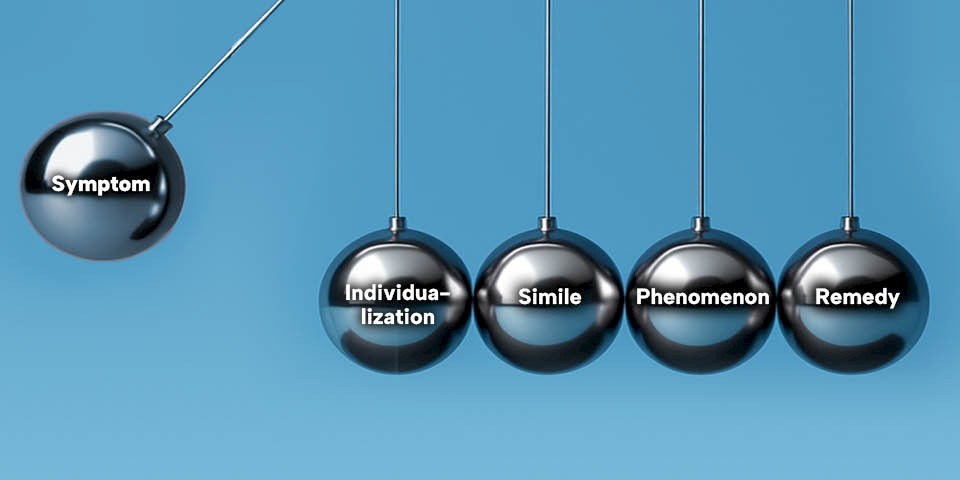The premises of homeopathy
Hahnemann describes the main features of this the first seven paragraphs of his Organon der Heilkunst. (Hahnemann, 2017, based on the 6th edition by Richard Haehl 1921)[1] . As was customary in such treatises at the time, the Organon is written in paragraphs and, figuratively speaking, follows the structure of a pyramid. The first paragraphs form the top and define the main features of the entire therapy. The premises mentioned in §§ 1 - 7 are systematically developed further in the other sections of the Organon and provided with detailed practical instructions. To gain a first impression, it is useful to read these first paragraphs in one go and analyse them epistemologically.
Organon §1
"The only and highest profession of the doctor is to make sick people well, which is called healing."
Organon §2
"The highest ideal of healing is the gentle, lasting restoration of health and the elevation and destruction of the disease in its entirety by the shortest, most reliable and most undiscriminating route, according to clearly recognisable reasons."
Organon §3
"If the physician clearly recognises what is to be cured in each individual case of disease (knowledge of the disease, indication), if he clearly recognises what is curative in the medicines, i.e. he sees clearly what is curative in the remedies, i.e. in each remedy in particular (knowledge of the medicinal powers), and he knows for clear reasons how to adapt the curative properties of the remedies to what he has undoubtedly recognised as pathological in the patient, so that recovery must take place, adapting them both with regard to the appropriateness of the most suitable remedy for the case according to its mode of action (choice of remedy, indication), and with regard to the exact preparation and quantity required (correct administration) and the appropriate repetition time of the administration: - Finally, if he knows the obstacles to recovery in each case and knows how to remove them so that the preparation is permanent, he knows how to act expediently and thoroughly and is a true healing artist."
Organon §4
"He is also a health-preserver if he knows the things that disturb health and cause and maintain illness and knows how to remove them from healthy people."
Organon §5
"The data of the most probable cause of the acute disease, as well as the most significant moments from the entire history of the protracted illness, serve the physician as an aid to healing, in order to find its root cause, which is usually based on a chronic miasm[2] , taking into consideration the recognisable physical constitution of the patient (especially of the protracted patient), his leisurely and mental character, his occupations, his mode of life and habits, his civil and domestic circumstances, his age and sexual function, etc., etc.etc. are to be taken into consideration."
Organon § 6
"The unprejudiced observer, - knowing the futility of supersensible reasonings which cannot be proved by experience, - perceives, even if he is the most acute, nothing in every single disease but changes in the state of the body and soul which are externally recognisable by the senses, signs of disease, coincidences, symptoms, that is, deviations from the healthy, former state of the now sick person, which he himself feels, which those around him perceive in him, and which the physician observes in him. All these perceptible signs represent the disease in its entirety, that is, together they form the true and only conceivable form of the disease"
Organon § 7
"Now, as nothing else can be perceived in a disease from which no cause (causa occasionalis) can be removed which apparently induces or maintains it, except the signs of the disease, so, with regard to any miasm and with regard to the secondary circumstances (§ 5.), it must also be only the symptoms by which the disease demands the remedy suitable for its aid and can point to the same - so the totality of its symptoms, this outwardly reflected picture of the inner nature of the disease, i.e., the suffering of the vital force, must be the most important or the only thing by which the disease can reveal which remedy it needs - the only thing which can determine the choice of the most appropriate remedy. i.e. the suffering of the vital force, must be the main or only thing by which the disease can indicate which remedy it needs, - the only thing that can determine the choice of the most appropriate remedy - so, in a word, the totality of the symptoms must be the main, indeed the only thing for the healer to recognise in every case of disease and to remove through his art, so that the disease is cured and transformed into health."

